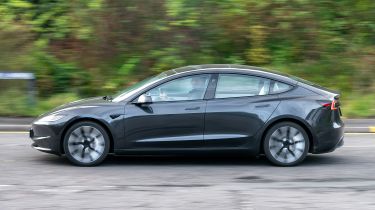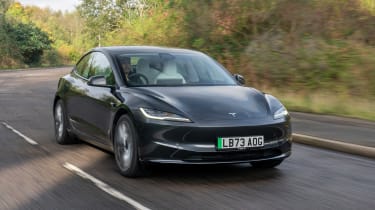Tesla Model 3 review - Range, charging & running costs
"You'll have to pay to use the Supercharger network, but a CCS charging port opens up the playing field"
The Model 3 is famously the first ‘affordable’ Tesla, following a long-held plan to release profitable and desirable sports, luxury and SUV all-electric models first in order to make a splash in the industry and help establish the brand. It has become even more affordable of late, following price cuts throughout 2023, meaning it now starts from just under £40,000 and undercuts many of its rivals.
Being the smallest and lightest model in the line-up, the Model 3 is also the most efficient. So, while every all-electric car should have low running costs, the Model 3 can go further between charges than most cars in its class. Unlike earlier models, charging a Model 3 using Tesla's own Supercharger network is no longer free, but it is also the first Tesla to get a CCS charging port instead of a proprietary one, opening up the use of many other public charging networks for a significant boost in convenience.
Universal access to Tesla's Supercharger network also gives Model 3 owners an advantage over rivals like the Polestar 2, because according to our Driver Power survey of charging networks, it’s by far the best to use.
Business drivers will benefit from significantly lower costs because the Model 3 sits in the lowest Benefit-in-Kind taxation band, while free VED (road tax) will also appeal to private customers, though this is due to end in April 2025, when EVs will also have to pay.
More reviews
In-depth reviews
Following the major facelift in 2023, there are four versions of the Tesla Model 3, starting with the rear-wheel drive Standard Range. This car’s battery is the smallest of the lineup, with a WLTP range of up to 318 miles on a charge, which is a big improvement over the old car.
Next up is the Long Range Rear-Wheel Drive model with an impressive range of 436 miles, which should be able to get you from London to Le Mans (via the Channel Tunnel) non-stop. It puts the Model 3 back above most rivals, with the Hyundai Ioniq 6 capable of 382 miles between charges, while the Polestar 2 Long Range Single can manage up to 406 miles. Go for the Long Range All-Wheel Drive model and range is still impressive at 390 miles, though that’s the price you pay for the extra grip.
The Model 3 Performance uses the same battery as the Long Range cars, but with a slightly shorter WLTP range of up to 328 miles owing to its extra power and even larger wheels.
The Model 3 supports fast charging (up to 170kW for the Standard Range and 250kW for versions with the big battery), which replenishes the battery pack to around 80% in as little as 30 minutes using the latest V3 or V4 Supercharger stations. Of course, many owners will carry out the majority of charging at home, where a 7kW wallbox will charge the standard car to 100% in around nine hours, increasing to around 12 hours for the Long Range. The Ioniq 6 has an 800-volt electrical system, providing a 0-80% charging in as little as 18 minutes.
| Model | Battery size | Range |
| Tesla Model 3 Standard Range | 57.5kWh | 318 miles |
| Tesla Model 3 Long Range RWD | 75kWh | 436 miles |
| Tesla Model 3 Long Range AWD | 75kWh | 390 miles |
| Tesla Model 3 Performance | 75kWh | 328 miles |
Insurance
Insurance groups for the Tesla Model 3 are very high, so it's important to get a quote before you buy one. Even the Standard Range version is in group 48 out of 50, while dual motor Long Range and Performance versions are in the same group 50 as Ferrari and Lamborghini supercars. Some EVs do start in lower groups, including the BMW i4 which starts in group 36.















